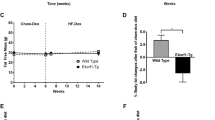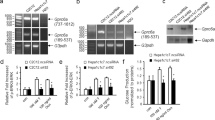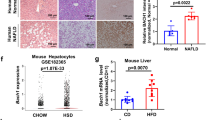Abstract
Background/objectives:
Juxtaposed with another zinc-finger gene 1 (TIP27 or JAZF1) is a 27-kDa transcription factor, and genome-wide association studies have recently revealed TIP27 to be associated with type 2 diabetes. However, little is known about its role in the regulation of metabolism. In this study, we investigated the effects of TIP27 overexpression on glucose homeostasis and insulin signaling in high-fat diet (HFD)-fed TIP27 transgenic (TIP27-Tg) mice and db/db mice.
Methods:
We assessed the effects of TIP27 overexpression in both TIP27-Tg mice and db/db mice on glucose metabolism and changes in insulin sensitivity during glucose (GTT) and insulin (ITT) tolerance tests. A hyperinsulinemic–euglycemic clamp was performed on TIP27-Tg mice. Real-time quantitative PCR and western blotting were used to assess mRNA and protein expressions.
Results:
TIP27 overexpression in TIP27-Tg mice and in db/db mice led to reduced total cholesterol and fasting plasma insulin levels, and enhanced glucose tolerance and insulin sensitivity during GTT and ITT. Hyperinsulinemic–euglycemic clamp experiments demonstrated that HFD-fed TIP27-Tg mice had lower hepatic glucose production and higher insulin sensitivity compared with nontransgenic littermates. In addition, the hepatic expressions of phosphoenolpyruate carboxykinase (PEPCK), glucose-6-phosphatase (G6Pase) mRNAs and proteins were significantly decreased, whereas the phosphorylation of insulin receptor, insulin receptor substrate-1, adenosine monophosphate-activated protein kinase and Akt kinase (Akt) in the liver was significantly increased in HFD-fed TIP27-Tg mice compared with nontransgenic littermates. Adenovirus-mediated TIP27 overexpression in db/db mice also decreased the expression of gluconeogenic genes and increased the phosphorylation of insulin signaling molecules in the liver compared with controls. Finally, LY294002, a phosphatidylinositol 3-kinase (PI3-kinase) inhibitor, abolished the suppressive effect of TIP27 overexpression on PEPCK and G6Pase expression.
Conclusions:
TIP27 has an important role in glucose homeostasis through the regulation of hepatic glucose metabolism and insulin sensitivity. Furthermore, this regulation requires activation of PI3-kinase.
This is a preview of subscription content, access via your institution
Access options
Subscribe to this journal
Receive 12 print issues and online access
$259.00 per year
only $21.58 per issue
Buy this article
- Purchase on Springer Link
- Instant access to full article PDF
Prices may be subject to local taxes which are calculated during checkout






Similar content being viewed by others
References
Bray GA . Medical consequences of obesity. J Clin Endocrinol Metab 2004; 89: 2583–2589.
Boden G . Role of fatty acids in the pathogenesis of insulin resistance and NIDDM. Diabetes 1997; 46: 3–10.
Reaven GM . Banting lecture 1988. Role of insulin resistance in human disease. Diabetes 1988; 37: 1595–1607.
Ingelsson E, Sundstrom J, Arnlov J, Zethelius B, Lind L . Insulin resistance and risk of congestive heart failure. JAMA 2005; 294: 334–341.
Zeggini E, Scott LJ, Saxena R, Voight BF, Marchini JL, Hu T, et al. Meta-analysis of genome-wide association data and large-scale replication identifies additional susceptibility loci for type 2 diabetes. Nat Genet 2008; 40: 638–645.
An P, Feitosa M, Ketkar S, Adelman A, Lin S, Borecki I, et al. Epistatic interactions of CDKN2B-TCF7L2 for risk of type 2 diabetes and of CDKN2B-JAZF1 for triglyceride/high-density lipoprotein ratio longitudinal change: evidence from the Framingham Heart Study. BMC Proc 2009; 3: S71.
Nakajima T, Fujino S, Nakanishi G, Kim YS, Jetten AM . TIP27: a novel repressor of the nuclear orphan receptor TAK1/TR4. Nucleic Acids Res 2004; 32: 4194–4204.
Kang HS, Okamoto K, Kim YS, Takeda Y, Bortner CD, Dang H, et al. Nuclear orphan receptor TAK1/TR4-deficient mice are protected against obesity-linked inflammation, hepatic steatosis, and insulin resistance. Diabetes 2011; 60: 177–188.
Yan ZH, Karam WG, Staudinger JL, Medvedev A, Ghanayem BI, Jetten AM . Regulation of peroxisome proliferator-activated receptor alpha-induced transactivation by the nuclear orphan receptor TAK1/TR4. J Biol Chem 1998; 273: 10948–10957.
Li L, Yang Y, Yang G, Lu C, Yang M, Liu H, et al. The role of JAZF1 on lipid metabolism and related genes in vitro. Metabolism 2011; 60: 523–530.
Ming GF, Xiao D, Gong WJ, Liu HX, Liu J, Zhou HH, et al. JAZF1 can regulate the expression of lipid metabolic genes and inhibit lipid accumulation inadipocytes. Biochem Biophys Res Commun 2014; 445: 673–680.
Li K, Li L, Yang GY, Liu H, Li SB, Boden G . Effect of short hairpin RNA-mediated adiponectin/Acrp30 down-regulation on insulin signaling and glucose uptake in the 3T3-L1 adipocytes. J Endocrinol Invest 2010; 33: 96–102.
Li L, Miao Z, Liu R, Yang M, Liu H, Yang G . Liraglutide prevents hypoadiponectinemia-induced insulin resistance and alterations of gene expression involved in glucose and lipid metabolism. Mol Med 2011; 17: 1168–1178.
Cheng KK, Iglesias MA, Lam KS, Wang Y, Sweeney G, Zhu W, et al. APPL1 potentiates insulin-mediated inhibition of hepatic glucose production and alleviates diabetes via Akt activation in mice. Cell Metab 2009; 9: 417–427.
Yang M, Zhang L, Wang C, Liu H, Boden G, Yang G . Liraglutide increases FGF-21 activity and insulin sensitivity in high fat diet and adiponectin knockdown induced insulin resistance. PLoS One 2012; 7: e48392.
Yang M, Zhang Z, Wang C, Li K, Li S, Boden G, et al. Nesfatin-1 action in the brain increases insulin sensitivity through Akt/AMPK/TORC2 pathway in diet-induced insulin resistance. Diabetes 2012; 61: 1959–1968.
Okamoto H, Latres E, Liu R, Thabet K, Murphy A, Valenzeula D, et al. Genetic deletion of Trb3, the mammalian Drosophila tribbles homolog, displays normal hepatic insulin signaling and glucose homeostasis. Diabetes 2007; 56: 1350–1356.
Liu NC, Lin WJ, Kim E, Collins LL, Lin HY, Yu IC, et al. Loss of TR4 orphan nuclear receptor reduces phosphoenolpyruvate carboxykinase-mediated gluconeogenesis. Diabetes 2007; 56: 2901–2909.
Jang WY, Bae KB, Kim SH, Yu DH, Kim HJ, Ji YR, et al. Overexpression of Jazf1 reduces body weight gain and regulates lipid metabolism in high fat diet. Bio Bio Res Com 2014; 444: 296–301.
Morrison KB, Tognon CE, Garnett MJ, Deal C, Sorensen PH . ETV6-NTRK3 transformation requires insulin-like growth factor 1 receptor signaling and is associated with constitutive IRS-1 tyrosine phosphorylation. Oncogene 2002; 21: 5684–5695.
Steinberg GR, Watt MJ, Ernst M, Birnbaum MJ, Kemp BE, Jorgensen SB . Ciliary neurotrophic factor stimulates muscle glucose uptake by a PI3-kinase-dependent pathway that is impaired with obesity. Diabetes 2009; 58: 829–839.
Agati JM, Yeagley D, Quinn PG . Assessment of the roles of mitogen-activated protein kinase, phosphatidylinositol 3-kinase, protein kinase B, and protein kinase C in insulin inhibition of cAMP-induced phosphoenolpyruvate carboxykinase gene transcription. J Biol Chem 1998; 273: 18751–18759.
Sutherland C, O'Brien RM, Granner DK . Phosphatidylinositol 3-kinase, but not p70/p85 ribosomal S6 protein kinase, is required for the regulation of phosphoenolpyruvate carboxykinase (PEPCK) gene expression by insulin. J Biol Chem 1995; 270: 15501–15506.
Schmoll D, Walker KS, Alessi DR, Grempler R, Burchell A, Guo S, et al. Regulation of glucose-6-phosphatase gene expression by protein kinase Balpha and the forkhead transcription factor FKHR. Evidence for insulin response unit-dependent and -independent effects of insulin on promoter activity. J Biol Chem 2000; 275: 36324–36333.
Yang M, Dai J, Jia Y, Suo L, Li S, Guo Y, et al. Overexpression of juxtaposed with another zinc finger gene 1 reduces proinflammatory cytokine release via inhibition of stress-activated protein kinases and nuclear factor-kB. FEBS J 2014; 281: 3193–3205.
Wellen KE, Hotamisligil GS . Inflammation, stress, and diabetes. J Clin Invest 2005; 115: 1111–1119.
Shoelson SE, Lee J, Goldfine AB . Inflammation and insulin resistance. J Clin Invest 2006; 116: 1793–1801.
Ming GF, Li X, Yin JY, Ai YH, Xu DM, Ma XH, et al. JAZF1 regulates visfatin expression in adipocytes via PPARα and PPARβ/δ signaling. Metabolism 2014; 63: 1012–1021.
Sun Q, Li L, Li R, Yang M, Liu H, Nowicki MJ, et al. Overexpression of visfatin/ pbef/nampt alters whole-body insulin sensitivity and lipid profile in rats. Ann Med 2009; 41: 311–320.
Acknowledgements
This work was supported by research grants from the National Natural Science Foundation of China (81270913, 81070640, 81100567, 81300702 and 81300670 to YG), Doctoral Fund of Ministry of Education of China (20105503110002, 20125503110003 to YG and LL) and Natural Science Foundation Key Project of CQ cstc (cstc2012 jjB10022 to YG).
Author information
Authors and Affiliations
Corresponding authors
Ethics declarations
Competing interests
The authors declare no conflict of interest.
Additional information
Supplementary Information accompanies this paper on International Journal of Obesity website
Rights and permissions
About this article
Cite this article
Yuan, L., Luo, X., Zeng, M. et al. Transcription factor TIP27 regulates glucose homeostasis and insulin sensitivity in a PI3-kinase/Akt-dependent manner in mice. Int J Obes 39, 949–958 (2015). https://doi.org/10.1038/ijo.2015.5
Received:
Revised:
Accepted:
Published:
Issue Date:
DOI: https://doi.org/10.1038/ijo.2015.5
This article is cited by
-
JAZF1 heterozygous knockout mice show altered adipose development and metabolism
Cell & Bioscience (2021)
-
Gut ghrelin regulates hepatic glucose production and insulin signaling via a gut-brain-liver pathway
Cell Communication and Signaling (2019)
-
JAZF1 ameliorates age and diet-associated hepatic steatosis through SREBP-1c -dependent mechanism
Cell Death & Disease (2018)
-
Interactome-transcriptome analysis discovers signatures complementary to GWAS Loci of Type 2 Diabetes
Scientific Reports (2016)



